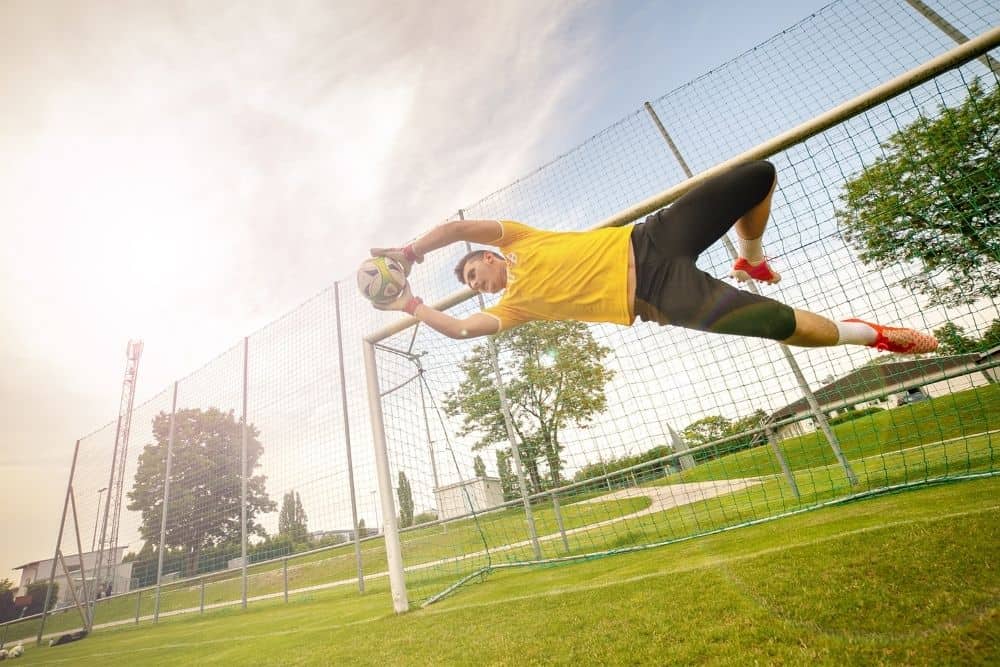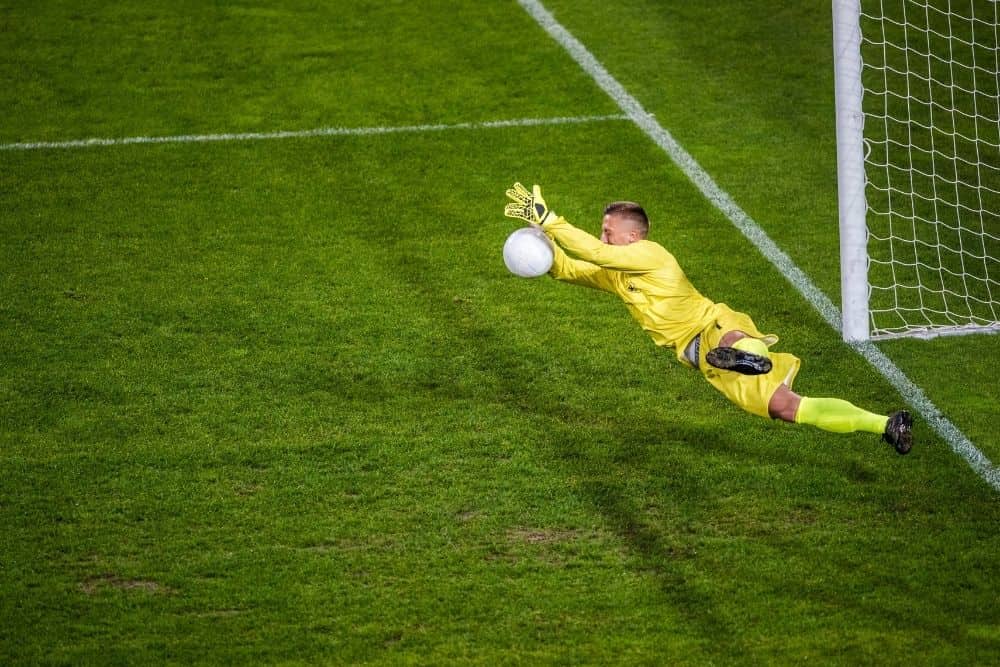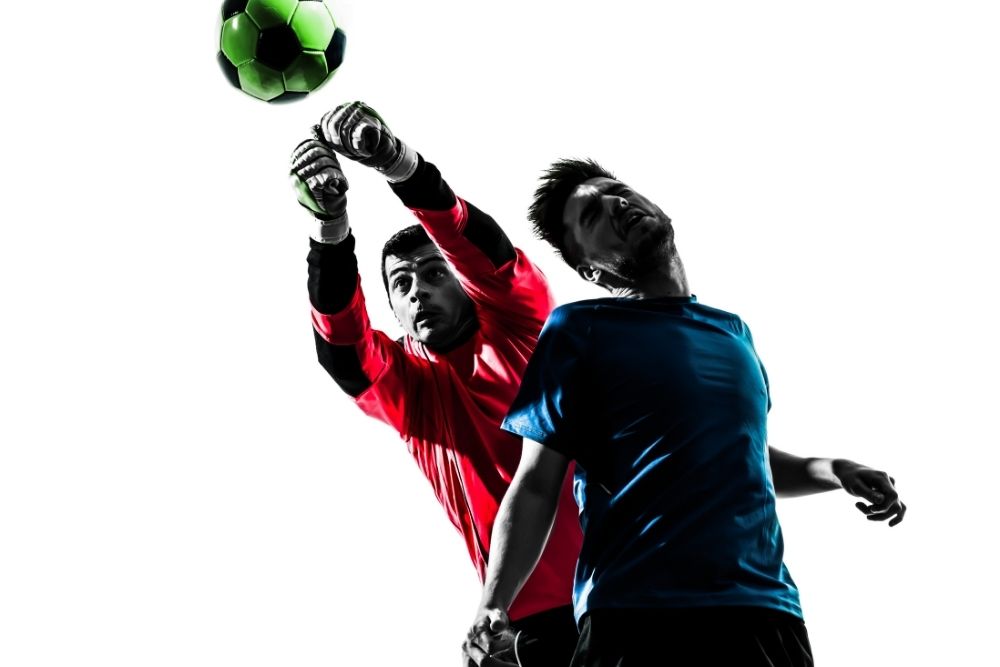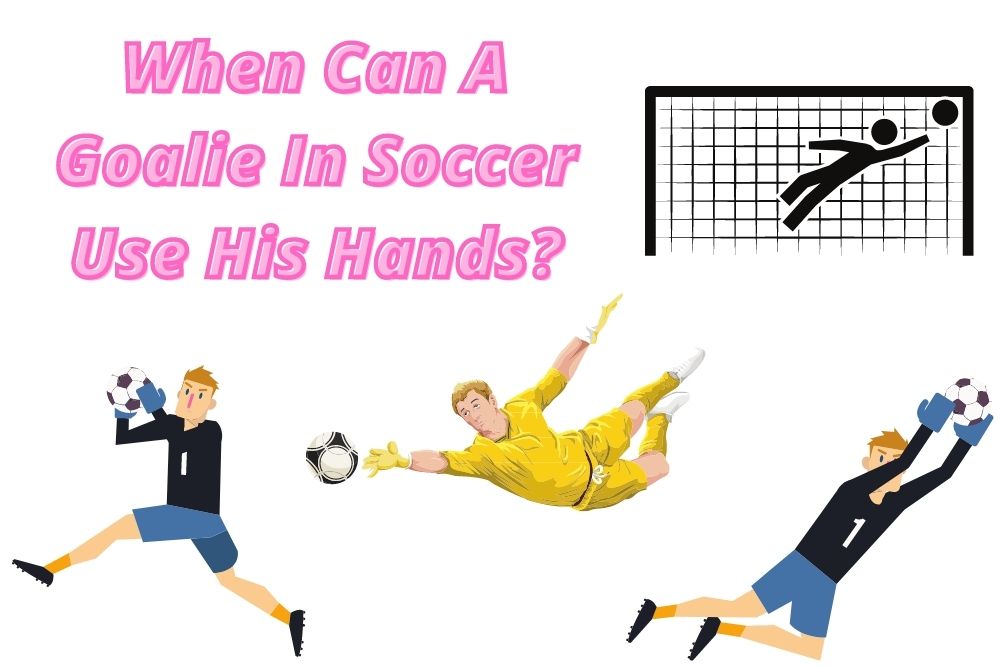The main objective in the game of soccer is for a team to score more goals than their opposing team. To achieve this, players have to move the ball around the pitch, either by passing, shooting, or heading to one another before making attempts to get the ball past the opposite team’s goalie into the net.
According to the official rules by the International Football Association Board (IFAB) and FIFA, players are not expected to touch the ball with their hands.
The only authorized player on the pitch, for each team, that is allowed to have contact with the ball during gameplay is the goalie. Although players are allowed to handle the ball with their hands during a throw-in.
In this article, we examine when a goalie can use his hands to touch the ball, the where, the why, the how, and when a goalie is not allowed to use his hands to handle the ball.
Quick Navigation
When Can A Goalie In Soccer Use His Hands?
Various situations determine when a goalie is allowed to use his hands. This makes him unique from the other players on the field.
Unlike in the game of basketball where contact with the ball is made with the hands, in soccer, even a goalie has limitations in when and where the ball can be handled with the hand.

The ball falls within the 18-yard box
The 18-yard box is otherwise known as the penalty box or the goalkeeping area. This is officially the designated area where the goalie is in charge of the ball.
The goalie decides the fate of the team by protecting the ball from entering the net or by failing to guard it and awarding a goal to the opposite team.
In this 18-yard box area, he is allowed to use his hands to prevent a goal from the opponent. This is permissible because the width of the net is sufficiently too wide to rely on just both feet. He does this by catching or punching the attacking shots out of the mouth of the goal post. Outside regular advancing attack play into the 18-yard box, he also blocks the ball, with his hand, during free kicks, corner kicks, etc.
Furthermore, as a goalie, he is also allowed, during a counter-attack, to throw the ball with his hands to his teammates who are outside the penalty box. Simply put, as long as the goalie has both feet in this 18-yard box, he is allowed to touch the ball with his hands.
Side-note: it is important to state that in determining when a soccer ball can be touched with the hand or arm by a goalie, the position of the ball on any area of the pitch supersedes the position of the goalie.
What does this mean? If the ball is judged to be within the 18-yard box and the goalie has a foot or both feet outside the box area, by the rules of soccer, the goalie is allowed to touch the ball with the hand.
An unintentional back pass
This situation is one of the most confusing for new fans of soccer. It is generally stated expressly in the IFAB Laws of the Game: Law 12 – Section 2, that a back pass from a goalie’s teammate cannot be picked or touched by the said goalie.
So what makes it legal to touch a back pass with the hands or arm? As long as the back pass wasn’t made with the feet from the goalie’s teammate, the goalie is allowed to touch with the hands – the goalie must be within the designated 18-yard box.
This would mean a player can use any part of his body (excluding his hands, of course) above his knee to send a back pass to his goalie.
Situations like these can include a back pass with a header, chest play, or an unintentional deflection from the player to his goalie. What constitutes an unintentional deflection? Well, that’s solely in the jurisdiction of the officiating match referee to decide.
For a maximum duration of 6 seconds
FIFA in all of its wisdom decided to limit the allowable time a goalie can hold on to the ball with his hands.
In the spirit of fair play and fairness to both playing teams, irrespective of the team winning or losing at any moment, to allow for the continuous flow of the game, goalies are not allowed to stop playing by holding on to the ball for too long.
Each team goalie is allowed a maximum of 6 seconds to hold on to the ball before resuming play – either by passing to the nearest teammates or shooting the ball far into the pitch.
A goalie has safely stopped an attacking shot and holds the ball in his hands. The goalie is smart enough to release it from his hands but makes a pass to a player.
As long as a player has had contact with the ball after releasing it from his (goalie) hands, the goalie is allowed to touch it again briefly before continuing play.
Side-note: This is allowed as long as it is not judged an intentional back pass. Please refer to “An unintentional back pass” for more clarification.
Directed shot from an opposing team player
As earlier stated, soccer aims to get as many goals into the net of the opposite team, as humanly possible.
The goalie expects a lot of shots to be directed towards the goal area and goal post by the opposing team. This is where one of the perks of being a goalkeeper comes into play.
The goalie is allowed to use his hands, arm, and/or legs to stop an intending attacking shot. Again, the use of hands is only permissible as long as the goalie remains within the 18-yard box.

Why Should a goalie use hands in soccer?
It’s a general rule in soccer that goalies can use their hands when the situation allows for it. That is what makes the sport unique from most of the other kinds of sport.
- Ball speed – A soccer ball, when shot with great power from a player towards the goal area, can only be safely caught or deflected effectively with the hands.
No matter how superb the players and their chosen formation maybe, in a soccer match, there are situations where the goalie will be put to test.
- Dimension of the goal post – The design and size of the net make it unrealistic for a goalie to solely depend on his feet. This does not prevent them from using their feet to defend their goal line. A pass or kick is still highly reliable, depending on the assessed situation.
- It is covered with protective gloves – Goalies have additional protective gear unlike what is officially obtainable with outfield players. This protective gear helps reduce injury to the palms. For shots coming at great velocity, a padded palm is safer to catch or deflect the ball, than any other part of a goalie’s body.
Why should a goalie not use his hands in soccer?
- It could lead to an indirect free-kick – Certain rules prevent the goalie from using his hands. If the goalie mistakenly or unintentionally uses his hands, in certain situations, it could result in an indirect free-kick. A good example is when an intentional back pass is made to the keeper from a member of his team
- It could lead to a direct free-kick – if a goalie touches the ball with his hands or arm outside the 18-yard box, this will be sanctioned with a direct free-kick to the opposing team
- He could be sanctioned with a card – indirect free-kicks often do not result in a card being shown. If the goalie handles the ball with his hands/arm outside his 18-yard box area, and it is deemed to have stopped play or prevented a promising attack from the opposite team, the goalie can be sanctioned with a yellow or red card – this is entirely at the discretion of the referee.
- During a promising counter-attack – soccer, as a movement sport, means the ball can be at the opposite side of the pitch this minute and is sent quickly to the other side in a quick play.
When a counter-attack situation presents itself, a goalie should refrain from using hands (as long as his goal area is not in immediate threat) to stop play. A quick succession shot towards the opponent’s goal creates better chances for the goalie’s attacking forward to create goal-scoring opportunities.
- To avoid a penalty – A penalty is a nightmare to any team it was awarded against. It can upset the balance of a game and the player’s morale.
A goalie should keep his hands to himself if it could intentionally or otherwise, cause a foul to be awarded to the opposite team.
How Can A Goalie Use His Hands?
- Punch – Punching is an effective way for a goalie to use his hands against the ball when it’s obvious he can’t catch it. Sometimes, he jumps and maneuvers his way to punch the ball from the reach of the opponent player during a corner kick or otherwise.
By clenching his closed fists together, he’s able to generate enough force to repel the ball away from the goal area, in times of impending danger.

- Parry – This is one important skill every goalie should possess because it depicts how well they dive and use their opened palm to push the ball away from the goal area or opponent. Goalies utilize this method when effectively catching the ball is impossible.
- Distribute – Goalies in this case help distribute the ball to their teammates by rolling or throwing the ball to them. This helps to balance the possession of the team and possibly create a chance for an attack against the other team.
- Anticipation and proper timing – jumping or running towards an attacking shot can be very dangerous for a goalie if not properly timed.
An expert goalie should have good eye-hand movement skills. This will help reduce the risk of injury and more successful catching and/or deflection of the ball.
- Extensive training – just like with all things sport, adequate training is needed to master the skills of a professional goalie. Goalies usually have special hand training sessions to help them use their hands effectively during gameplay.
Here are the rules, as highlighted in the Laws of the Game, which supervise the gameplay of a goalie during an official soccer match.
- When the goalkeeper has the ball between his hands, the rules stipulate that he is in control. The same applies if the ball falls between his hands and a surface. According to the rules, a surface here could be his body, the field, etc
- The goalkeeper shares the same restrictions on ball handling with hands or arms, just like other players on the pitch, when he is out of the goal area.
- Obstructing the progress of a promising attack with any part of his body (within the goal area), including the hands, is considered a foul and can lead to a penalty and card sanction.
- A team cannot exchange a player with its goalie without express permission from the match referee. In other words, only the referee has the right to bestow the ball-handling privilege enjoyed by the goalie to another outfield player.
- A goalie is cautioned if found to have acted in an unsportsmanlike manner by intentionally tricking the referee with a play with any other part of his body, excluding his hands.
- Engaging in violent conduct that may include using hands or any other body part to forcefully hit, injure or prevent play for his opponent.
Can the goalkeeper use his hand out of his area?
No, the goalie cannot use his hand out of his area. This is because there are laid down rules and restrictions governing a goalie’s match play.
The penalty box is where he is most qualified to use his hands for various functions. He can choose to save, punch, parry, and distribute the ball to his teammates if he so desires.
Conclusion
Unless you’re not a soccer fanatic, one would think the rule of thumb stipulates that goalies are allowed to touch the ball at all times. This idea could be born from the fact that goalies are hardly known to leave their goal area.
As a rising professional goalie in soccer, it is necessary to acquaint oneself with the IFAB and FIFA rules governing when and when not a goalie is officially allowed to handle the ball with the hand or arm.
Hi there, I’m Jay.
Soccer is everything in my life! My friends and I have created this blog with all our enthusiasm, passion, and understanding after years of playing pro soccer. Hope you will enjoy it!
